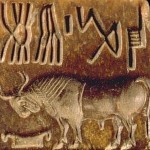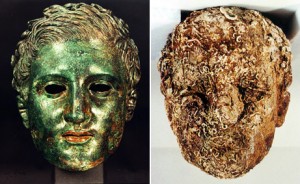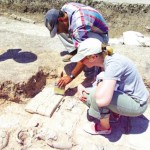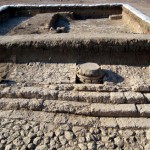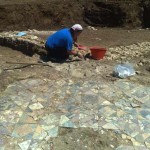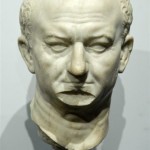The debate over whether the British Museum should return the Parthenon Marbles to Greece is picking up steam in the wake of recent successful antiquities repatriation campaigns, and the opening of the new, state of the art Acropolis Museum.
The new museum eliminates one of the British Museum’s primary excuses for keeping the frieze sculptures removed by Lord Elgin in the first decade of the 19th century, ie, that they can preserve them better in London than the Greeks can in Athens.
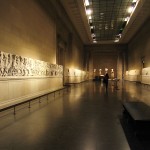 Not that that contention was particularly valid even before the new museum opened, mind you.
Not that that contention was particularly valid even before the new museum opened, mind you.
The British Museum has a lot to answer for in terms of damage done to the marbles in various disastrous “cleanings” using tools like brass brushes and industrial abrasives which scoured off the precious traces of original paint and removed an estimated 1/8 of an inch of the marble surface.
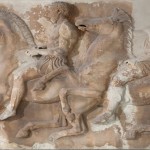 The frieze sculptures that remained on the Parthenon, on the other hand, may have been caked in soot and pollution for thousands of years, but when they were taken down and restored in 1993, the careful double laser treatment revealed details like veins on the horses’ bellies and original chisel marks long gone from Elgin’s poor butchered ones.
The frieze sculptures that remained on the Parthenon, on the other hand, may have been caked in soot and pollution for thousands of years, but when they were taken down and restored in 1993, the careful double laser treatment revealed details like veins on the horses’ bellies and original chisel marks long gone from Elgin’s poor butchered ones.
So anyway, the new museum isn’t just a hint. The Greeks are out-and-out demanding that the frieze sculptures in England be returned to Athens to join their brothers and sisters.
An animated short directed by famed Greek-born auteur Costa-Gavras showing the damage done to the Parthenon over the centuries plays in the museum, making its return agenda very clear indeed.
The film caused some controversy because of a few seconds of footage in which figures in black are seen knocking chunks of marble off the frieze and replacing them with a cross. Although it’s a known fact that Christians used Parthenon marble for construction and destroyed pagan imagery to convert the structure into a church, the Greek Orthodox Church got mad and those 12 seconds of the film were cut.
Then everyone else got mad, including Costa-Gavras, so the footage was put back in after “clarifying” that the figures in black weren’t meant to be actual priests but just representatives of the people whodunit. (Pretty much all the figures in the short are black shadowy looking things anyway, so it was an obvious point, imo. Guilty conscience much?)
Now the entire short is on YouTube, and it’s astonishing to me that anyone could give a rat’s ass about the Christian destruction aspect given the rousing Elgin-and-Britain-bashing finale. The whole video is compelling, but the focus is definitely on Elgin’s removal of the frieze.
The only voice-over begins at the 4:30 mark, and it’s a recitation of excerpts from Lord Byron’s “The Curse of Minerva,” which he wrote in Athens in 1811, while Elgin was almost but not quite finished despoiling the place. (He removed the last of his marbles in 1812.)
Watch the whole thing because it’s awesome:
[youtube=http://www.youtube.com/v/1rFgq7MsRe8&w=430]
HARDCORE, RIGHT?! Here’s the full text from the video:
“Mortal!”—’twas thus [Athena] spake — “that blush of shame
Proclaims thee Briton, once a noble name;
First of the mighty, foremost of the free,
Now honoured ‘less’ by all, and ‘least’ by me:
Chief of thy foes shall Pallas still be found.
Seek’st thou the cause of loathing!—look around.
Lo! here, despite of war and wasting fire,
I saw successive Tyrannies expire;
‘Scaped from the ravage of the Turk and Goth,
Thy country sends a spoiler worse than both.
Survey this vacant, violated fane;
Recount the relics torn that yet remain:
‘These’ Cecrops placed, ‘this’ Pericles adorned,
[…]
What more I owe let Gratitude attest—
Know, Alaric and Elgin did the rest.
That all may learn from whence the plunderer came,
The insulted wall sustains his hated name:
[…]
Be ever hailed with equal honour here
The Gothic monarch and the Pictish peer:
Arms gave the first his right, the last had none,
But basely stole what less barbarians won.
So when the Lion quits his fell repast,
Next prowls the Wolf, the filthy Jackal last:
[…]Some calm spectator, as he takes his view,
In silent indignation mixed with grief,
Admires the plunder, but abhors the thief.
That’s playing in the museum, y’all, and even with all the press over the religion controversy, nobody once mentioned this dramatic fuck you to Britain. Color my mind blown.
For a handy and entertaining presentation of the issues in the Elgin debate, see James Cuno (director of the Art Institute of Chicago and proponent of “universal museums” getting to keep all the stuff they stole/conquered/bought from thieves) and Christopher Hitchens (journalist and long-time advocate for the return of the Parthenon marbles) go at it on PBS.
